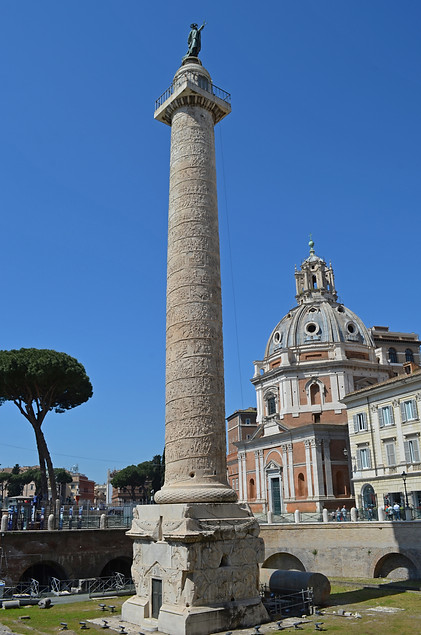Column of Trajan
The Column of Trajan was erected to commemorate the victories of Trajan in Dacia. While located in the Forum of Trajan, it was not erected in the main open space of the forum, but rather was in a small colonnaded court between two libraries behind the Basilica Ulpia. It has been assumed that the architect Apollodorus of Damascus was responsible for its construction in 113 AD.
Standing around 38 meters tall, this monument consists of a column composed of 19 Luna marble drums set on a high rectangular block. The column decorated with a series of reliefs depicting the campaigns of Trajan in Dacia (101-106 AD). The relief frieze is around 200 meters long in a continuous sequence of 155 scenes, containing over 2,600 figures. Plaster casts of these reliefs can be found at the Museo della Civilta Roman in Rome.
As the frieze shows realistic details of the life, organizations and other activities of the Roman army, is an important document for the history of Dacia and the study of Roman military tactics and equipment. Trajan himself is frequently represented and emphasized in the reliefs by being portrayed clearly and slightly larger. Whether the reliefs were colors and how legible they were from the ground are debated questions. It has also been argued that the relief spiral intentionally resembles a scroll, though this is not universally accepted.
A statue of Trajan originally crowned the column. There was also a platform on top of the capital which had a metal fence around it, allowing for a panoramic view of the area. This could be reached by a staircase of 185 steps lit by tiny windows inside the column, which could be entered by a doorway in the base. It is generally held that the ashes of Trajan and his wife Pompeia Plotina were placed in urns a chamber of this base. The base was decorated with Dacian armor, while the torus of the column base is carved in the form of a victor's laurel wreath. This column would later serve as the model for the Column of Marcus Aurelius in Rome, as well as the Column of Theodosius and the Column of Arcadius in Constantinople.
The base of the column was converted into the Church of S. Nicola de Columna, which was later deconsecrated in the 16th century. In 1588 Pope Sixtus V had the present bronze statue of Saint Peter by Giacomo della Porta erected atop the column to replace the long lost statue of Trajan.
Column of Trajan and ruins of the Forum of Trajan
Inscription
SENATUS POPULUSQUE ROMANUS
IMP(eratori) CAESARI DIVI NERVAE F(ilio) NERVAE
TRAIANO AUG(usto) GERM(anico) DACICO PONTIF(ici)
MAXIMO TRIB(unicia) POT(estate) XVII IMP(eratori)
VI CO(n)S(uli) VI P(atri) P(atriae)
AD DECLARANDUM QUANTAE ALTITUDINIS
MONS ET LOCUS TANT[IS OPER]IBUS SIT EGESTUS
The Senate and people of Rome [dedicated this column] to the Emperor Caesar Nerva Trajan Augustus Germanicus Dacicus, son of the deified Nerva, Pontifex Maximus, with tribunician power for the 17th time, hailed as Imperator for the 6th time, consul for the 6th time and Father of his Country, to show the height and location of the hill removed for such great structures.
Depiction of Column Base by Piranesi (18th century)
Image from Harvard
Trajan’s Column by Piranesi (1758)
Sources
A New Topographical Dictionary of Ancient Rome by L. Richardson, Jr.
Rome: An Oxford Archaeological Guide by Amanda Claridge
Two Romes: Rome and Constantinople in Late Antiquity edited by Grig and Kelly
Rome Alive: A Source Guide to the Ancient City, Vol. 1 by Peter J. Aicher
Resources
Column of Trajan Album (Byzantine Legacy Flickr)
Column of Trajan (Khan Academy)
Description and Condition of Trajan’s Column (University of St Andrews)






